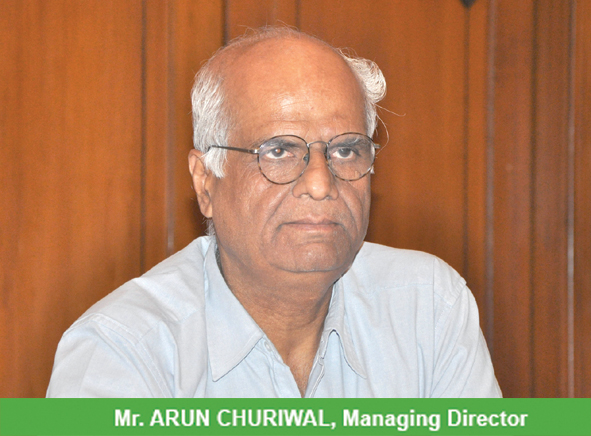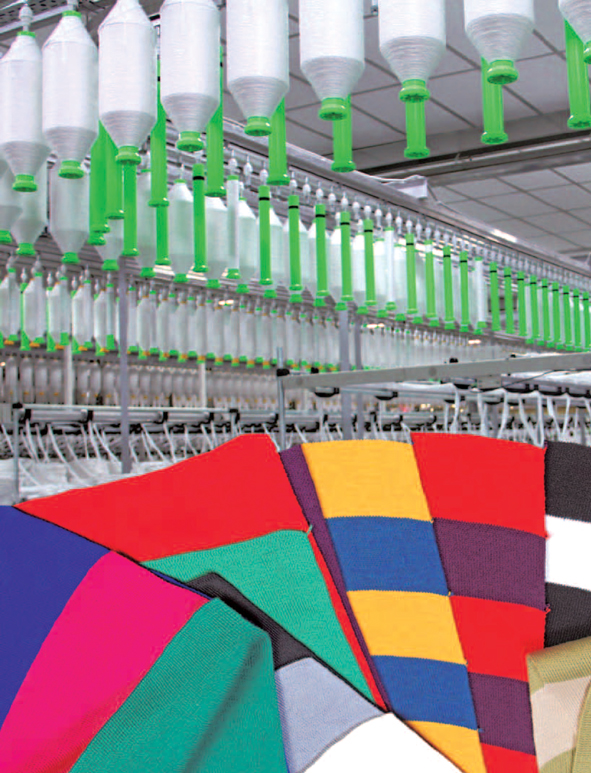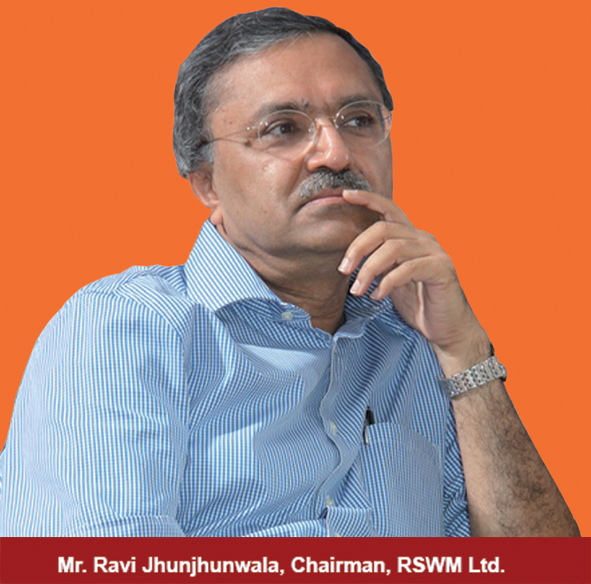By K. Gopalakrishnan
 RSWM is a leading manufacturer of synthetic and blended spun yarn, polyester viscose fabric and denim fabric. It is also one of the largest exporters of synthetic yarn from India and has a commanding position in the domestic market too. The company has its presence in the cotton yarn spinning and fabric processing segments.
RSWM is a leading manufacturer of synthetic and blended spun yarn, polyester viscose fabric and denim fabric. It is also one of the largest exporters of synthetic yarn from India and has a commanding position in the domestic market too. The company has its presence in the cotton yarn spinning and fabric processing segments.
The year 2011-12 was a mixed bag for RSWM. The first three quarters were tough and turbulent, but the last quarter was most encouraging. The damage done in the first three quarters was relieved to an extent by the last quarter.
The turnover of the compan y during the year increased by 1.94 per cent to Rs. 2,000.15 crores from Rs. 1,962.16 crores in 2010-11. This growth was on account of higher volume and better realisation. Exports touched Rs. 730.35 crores.
y during the year increased by 1.94 per cent to Rs. 2,000.15 crores from Rs. 1,962.16 crores in 2010-11. This growth was on account of higher volume and better realisation. Exports touched Rs. 730.35 crores.
As part of its 50th years celebration, RSWM announced the ‘Lakshya 2016’ programme with a targeted turnover of Rs. 4,500 crores involving a capex of Rs. 1,500 crores in a phased manner to be achieved by 2016. The first phase of the programme has already been undertaken involving a capex of Rs. 355 crores.
 The programme consists of expansion of capacity by 51,840 spindles for producing synthetic yarns, 10,632 spindles and 2,400 open-end rotors for making cotton yarn, as well as expansion of weaving capacity with matching spinning facility to increase denim fabric manufacturing capacity by 2.7 million metres. Of the proposed expansion, installation of 1,440 rotors and denim fabric manufacturing capacity have been completed successfully during the year under review. In carrying out these investments, the company continues to benefit from the Technology Upgradation Fund Scheme (TUFS).
The programme consists of expansion of capacity by 51,840 spindles for producing synthetic yarns, 10,632 spindles and 2,400 open-end rotors for making cotton yarn, as well as expansion of weaving capacity with matching spinning facility to increase denim fabric manufacturing capacity by 2.7 million metres. Of the proposed expansion, installation of 1,440 rotors and denim fabric manufacturing capacity have been completed successfully during the year under review. In carrying out these investments, the company continues to benefit from the Technology Upgradation Fund Scheme (TUFS).
Yarn business
RSWM offers one of the broadest range of products in terms of fibre blends, counts and shades. Fibres processed by the company include polyester, viscose, acrylic, cotton, wool, rayon, nylon, silk, polyamide and linen. In addition, it produces a range of speciality items made out of both unorthodox fibres such as soya protein, milk protein, bamboo, bamboo-charcoal, and branded fibres such as Tencel, Greenplus, Protex, X-static, Beltron, Huvis FR Polyester, Trevira CS, Coolmax, Coolplus, Birla Modal, Excel, Viloft, Cupro, Lycra, Clima, Seacel, Dupont’s Sorona, Teijin Conex, Tworon and Ingeo (PLA). Many of these yarns have been developed for specific applications and have functional qualities such as natural stretch, flame retardance and industrial usage.
Currently, the company’s yarn business accounts for 82.80 per cent of the total turnover. Yarn production has increased primarily because of better plant management and commercial production from expansion taken up and completed during this financial year.
It may be noted that the yarn production figures do not represent production from Cheslind Textiles Ltd. (CTL), which operates as a subsidiary of RSWM. The current yarn portfolio of RSWM can be classified into three main categories – greige yarn, dyed yarn and mélange yarn.
Greige yarn
Greige yarns are produced from different synthetic fibres such as polyester and viscose, blends of synthetic and natural fibres and pure cottons. Greige yarns are produced at the company’s Banswara and Rishabhdev and partly at the Kharigram plant. Although greige yarn constitutes a relatively lower value-added segment vis-à-vis dyed and melange, it is by far the largest in terms of volume and is crucial to the product portfolio offered to customers.
 Dyed yarns are produced at the company’s Kharigram and Ringas plants. These are relatively higher value-added products and made according to customer specifications of blends, counts and shades.
Dyed yarns are produced at the company’s Kharigram and Ringas plants. These are relatively higher value-added products and made according to customer specifications of blends, counts and shades.
Melange yarns are premium products made from cotton and its blends and are used in the production of knitwear and hosiery. Today, the company is one of the largest manufacturers of mélange yarn in the country with 44,016 spindles. While this segment is still quantitatively small compared to the greige and dyed yarn business of the company, it commands the highest value addition in RSWM’s overall yarn portfolio.
The fabric and denim business segment comprises fabric manufacturing capacity, which consists of the blended fabrics division with fabric processing plant at Mordi (Rajasthan) and the fully integrated state-of-the-art denim plant from spinning to value-added denim fabrics at the same location.
Blended fabrics
RSWM manufactures a range of blended suiting fabrics and has a significant presence in the domestic market with its ‘Mayur’ brand. The company’s process house at Mordi is fully integrated with weaving and processing, with an annual capacity of 10 million metres. The company has been regularly coming out with new ranges catering to changing customer needs.
The company had launched new ranges with the latest colour palette like Vivanta, Alberto, Dorma, Brostal, Domino, Fantum, Anniva and Old Trafford. The strategy for branding and innovating to address the customer needs and preferences is likely to reap benefits for the company in the near future.
RSWM has a fully integrated state-of-the-art denim manufacturing plant at Mordi, with an annual capacity of 14 million metres of fabric. This project also includes a yarn spinning facility to aid in maintaining superior quality and higher degree of reliability and client servicing. The facility also has an in-house small garmenting department to cater to development of denim apparel samples for the benefit of customers. The business is in line with the company’s strategy to move to higher value-added segments for a more broad-based growth in the future.
Manufacturing capacities
RSWM currently has eight manufacturing facilities at six locations, namely, Kharigram, Mandpam, Banswara, Rishabhdev, Ringas and Mordi. All these locations are in Rajasthan and are self-sustainable units with manufacturing facilities, captive power generation, utilities and residential colonies for the staff and workers. The company also has its presence in two more locations, in Tamil Nadu and Pondicherry, through its subsidiary CTL.
All the plants specialise in production of specific product categories and are capable of producing intra-segment variants. Ringas, which is one of the smaller units of the company, specialises in dyed blended yarns. The Kharigram plant produces both dyed and greige blended yarns. The unit at Mandpam specializes in fibre-dyed mélange yarns and 100 per cent cotton dyed yarns. The Rishabhdev plant produces blended greige yarn from synthetic fibres. The Banswara unit, which is one of the larger facilities, focuses on blended greige yarns from synthetic and natural fibres and cotton yarns.
There are two plants located at Mordi: an integrated unit with a process house and weaving for manufacture of blended fabrics and a fully integrated unit with spinning and weaving facilities and process house for manufacture of denim fabrics.
 According to Mr. Ravi Jhunjhunwala, Chairman, RSWM, the year 2011-12 was one of the most challenging in living memory where circumstances external to the company eroded profitability. The result was that despite a marginal topline increase, there was a net loss of Rs. 21.79 crores – one of the few such instances in the recent past. It would not be out of place to indicate that the company finished the year under review better off than others in the industry.
According to Mr. Ravi Jhunjhunwala, Chairman, RSWM, the year 2011-12 was one of the most challenging in living memory where circumstances external to the company eroded profitability. The result was that despite a marginal topline increase, there was a net loss of Rs. 21.79 crores – one of the few such instances in the recent past. It would not be out of place to indicate that the company finished the year under review better off than others in the industry.
This decline was largely due to sharp fluctuations in raw cotton prices, high inventory cost, depressed economic conditions and reduced US and European consumer spends. However, it would be important to reiterate that the long-term prospects of the Indian textile industry (yarn, fabric and denim) remain bright.
Factors that will accelerate demand
One is optimistic of the prospects of India’s textile sector for some good reasons:
Population growth: India’s population rose 181 million to 1.21 billion in the last 10 years. Based on the existing trend, India will cross China’s population by 2030.
Increasing affluence: According to data of the Ministry of Statistics & Programme Implementation, India’s urbanisation is expected to increase from 30 per cent to 40 per cent over the coming decade. The 2.4 per cent CAGR is among the fastest urbanisation rates in the world.
Growing youth: Half of India’s population is below 25. Interestingly, the working age has declined sharply, generating higher disposable incomes. Close to 65 per cent of Indians of 20-60 years are working, leading to higher disposable incomes and lifestyle aspirations. Among the BRIC nations, India is expected to remain the youngest with its working-age population estimated to rise to 70 per cent of the total population by 2030 – the largest in the world.
Wealth at the bottom: Rural income is increasing significantly. Credible estimates suggest that a one per cent increase in India’s rural income translates into $25 billion of buying power.
These factors are expected to drive demand for textiles and yarn in India.
Buoyancy in the man-made fiber space: The domestic fibre consumption ratio in India is 41:59 between man-made fibres and cotton, while it is almost 60:40 at the global level. A growing paucity of agricultural land will tilt the ratio more in line with the global average. More importantly, the global ratio is expected to tilt in favour of man-made fibres due to limited cotton availability and growing land shortage.
India’s growing focus on strengthening its food security (Union Budget 2012) is expected to result in favourable policies, making food crops more attractive and reducing the land availability for cash crops.
Considering an average eight per cent GDP growth in the current decade, domestic demand for man-made fibres/filament yarns is estimated at 4.2 billion kg in 2014-15 and about 6.48 billion kg in 2019-20 (after adjusting for likely exports and imports). This implies capacity additions of about 1.8 billion kg (2014-15) and 4.6 billion kg (2019-20), which will require an investment of around $2 billion by 2014-15 and $5.1 billion by 2019-20.
The game plan
At RSWM, we are investing in sophisticated capacity creation. We are investing in fully-automated, state-of-the-art units to house contemporary equipment, requiring lesser land, people and utilities to produce quality, niche products with global acceptance.
This has been reflected in our 51,840-spindle unit at Kharigram, reinforcing our position as one of the largest players in India’s spinning segment and 18,000 spindle addition in our denim unit. We should commence operations by the end of the first quarter of 2012-13. Our Lakshya is 7,00,000 spindles by 2016, enabling us to capitalise on emerging opportunities in India and the world.
Our dual strategy of combining capacity and technology will position us among leading global textile players.